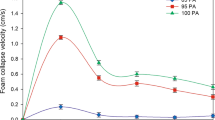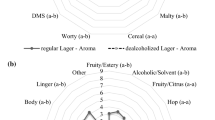Abstract
The practice of dealcoholization is used nowadays to reduce the alcohol content in beverages, and osmotic distillation seems to be a convenient membrane process due to its mild operating conditions. The focus is on the quality of final beverage which may lack in taste, flavor, and body. The aim of this work was to evaluate the quality attributes of low-alcohol beers, dealcoholized by osmotic distillation and using stripping solutions specific for the beverage composition. Two types of top-fermented beer were used: Weiss beer, with a very fruity aroma and strong phenolic content, and Bitter beer, with a malt aroma. Regarding the stripping solutions, they were obtained by dilution of the original beer with water, in order to limit the volatile compound loss during the process. Moreover, low-alcohol Weiss beer was also produced by using carbonated stripping solutions (i.e., saturated with CO2 at ambient pressure). The results highlighted that color, bitterness, total phenols, and antioxidant activity were unchanged in the low-alcohol beers but volatile compounds were reduced to a different extent. The lower vapor pressure of some volatile compounds (i.e., 2-phenylethanol, aldehydes) can explain their retention in beer. The carbonation of stripping solutions did not significantly reduce CO2 loss, but aldehydes and total alcohols were better retained in low-alcohol Weiss beer. Esters and other volatile compounds were reduced so that the low-alcohol beer may result with a weak sensory profile, which can be compensated by a re-addition of CO2 before bottling.



Similar content being viewed by others
References
Albanese, D., Cinquanta, L., Cuccurullo, G., & Di Matteo, M. (2013). Effects of microwave and hot-air drying methods on colour, β-carotene and radical scavenging activity of apricots. Int J Food Sci Technol, 48, 1327–1333.
Alonso García, A., Cancho Grande, B., & Simal Gándara, J. (2004). Development of a rapid method based on solid-phase extraction and liquid chromatography with ultraviolet absorbance detection for the determination of polyphenols in alcohol-free beers. J Chromatogr A, 1054(1–2), 175–180. doi:10.1016/j.chroma.2004.07.092.
Analytica (2008). EBC European Brewery Convention. Fachverlag Hans Carl: CL Druckzentrum GmbH. Nurnberg
Beer Judge Certification Program (BJCP) (2008). Style guidelines for beer, mead and cider, BJCP, Inc.
Brand-Williams, W., Cuvelier, M. E., & Berset, C. (1995). Use of a free radical method to evaluate antioxidant activity. Lebensm.-Wiss. Technol., 28, 25–30.
Brányik, T., Silva, D. P., Baszczyňski, M., Lehnert, R., & e Silva Almeida, J. B. (2012). A review of methods of low alcohol and alcohol-free beer production. J Food Eng, 108(4), 493–506.
Briggs, D. E., Boulton, C. A., Brookes, P. A., & Stevens, R. (2004). Brewing science and practice. Abington Hall, Abington Cambridge CB1 6AH, England: Woodhead Publishing Limited Eds.
Bryant, D. (2010). German Wheat Beer Yeast and Fermentation (Proceedings of Meeting). Asheville, NC: Highland Brewing Com.
Caluwaerts, H.J.J. (1995). Process for the manufacture of an alcohol-free beer having the organoleptic properties of a lager type pale beer. United States Patent.
Catarino, M., & Mendes, A. (2011). Non-alcoholic beer—a new industrial process. Sep Purif Technol, 79(3), 342–351.
Catarino, M., Mendes, A., & Madeira, L. M. (2007). Alcohol removal from beer by reverse osmosis. Sep Sci Technol, 42, 3011–3027.
Clark, R. A., Hewson, L., Bealin-Kelly, F., & Hort, J. (2011). The interactions of CO2, ethanol, hop acids and sweetener on flavor taste in a model beer. Chemosensory Taste, 4(1–2), 42–54.
De Francesco, G., Freeman, G., Lee, E., Marconi, O., & Perretti, G. (2014). Effects of operating conditions during low-alcohol beer production by osmotic distillation. J. Agric. Food Chem., 62(14), 3279–3286.
Engan, S. (1991). Off-flavors in beer. Brauwelt International, 3, 217–223.
Fumi, M. D., Galli, R., Lambri, M., Donadini, G., & De Faveri, D. M. (2011). Effect of full-scale brewing process on polyphenols in Italian all-malt and maize adjunct lager beers. J Food Compos Anal, 24, 568–573.
Goldammer, T. (2008). In T. Goldammer (Ed.), The brewer’s handbook. The complete book to brewing beer (Secondth ed.). USA: Apex publishers.
Huige, N.J., Sanchez, G.W., Leidig, A.R. (1990). Process for preparing a nonalcoholic (less the 0.5 volume percent alcohol) malt beverage. US Patent.
Jentsch, M. (2007). Top-fermented beer specialties in focus. Brauwelt International, 5, 332–334.
Kobayashi, M., Shimizu, H., & Shioya, S. (2008). Beer volatile compounds and their application to low-malt beer fermentation. J Biosci Bioeng, 106(4), 317–323. doi:10.1263/jbb.106.317.
Leskosek, I., Nedovic, V., & Petkovska, M. (1997). Effect of convective mass transfer on beer diafiltration. J Inst Brew, 103(5), 279–282.
Liguori, L., De Francesco, G., Russo, P., Albanese, D., Perretti, G., & Di Matteo, M. (2015a). Quality improvement of low craft beer produced by evaporative pertraction. Chem Eng Trans, 43, 13–18. doi:10.3303/CET1543003.
Liguori, L., De Francesco, G., Russo, P., Perretti, G., Albanese, D., & Di Matteo, M. (2015b). Production and characterization of alcohol-free beer by membrane process. Food Bioprod. Process., 94, 158–168. doi:10.1016/j.fbp.2015.03.003.
Liguori, L., Russo, P., Albanese, D., & Di Matteo, M. (2013a). Evolution of quality parameters during red wine dealcoholization by osmotic distillation. Food Chem, 140, 68–75.
Liguori, L., Russo, P., Albanese, D., & Di Matteo, M. (2013b). Effect of process parameters on partial dealcoholization of wine by osmotic distillation. Food Bioprocess Technol., 6, 2514–2524.
Malfliet, S., Opstaele, F. V., Clippeleer, J. D., Syryn, E., Goiris, K., Cooman, L. D., & Aerts, G. (2008). Flavour instability of pale lager beers: determination of analytical markers in relation to sensory ageing. J. Inst. Brew., 114(2), 180–192.
Meilgaard, M. C. (1975). Flavor chemistry of beer: part II: flavor and threshold of 239 aroma volatiles. Tech. Q. Master Brew. Assoc. Am., 12, 151–168.
Narziss, L., Back, W., & Stich, S. (1993). Alcohol removal from beer by countercurrent distillation in combination with rectification. Brauwelt International, 133(38), 1806–1820.
Perpete, P., & Collin, S. (1999). Contribution of 3-methylthiopropionaldehyde to the worty flavor of alcohol-free beers. J. Agric. Food Chem., 47(6), 2374–2378.
Pickering, G. J. (2000). Low-and reduced-alcohol wine: a review. Journal of Wine Research, 11(2), 129–144.
Pires, E., Teixeira, J., Brányik, T., Vicente, A. (20149. Yeast: the soul of beer’s aroma—a review of flavor-active esters and higher alcohols produced by the brewing yeast. Applied Microbiology and Biotechnology, 1–13 doi:10.1007/s00253-013-5470-0.
Russo, P., Liguori, L., Albanese, D., Crescitelli, A., & Di Matteo, M. (2013). Investigation of osmotic distillation technique for beer dealcoholization. Chem Eng Trans, 32, 1735–1740.
Salo, P., Nykänen, L., & Suomalainen, H. (1972). Odor thresholds and relative intensities of volatile aroma components in an artificial beverage imitating whisky. J Food Sci, 37(3), 394–398.
Singleton, V., & Rossi, J. (1965). Colorimetry of total phenolics with phosphomolybdic phosphotungstic acid reagents. Am J Enol Vitic, 16, 144–158.
Sohrabvandi, S., Mousavi, S., Razavi, S., Mortazavian, A., & Rezaei, K. (2010). Alcohol-free beer: methods of production, sensorial defects and healthful effects. Food Reviews International, 26(4), 335–352.
Sohrabvandi, S., Mousavi, S. M., Razavi, S. H., & Mortazavian, K. R. (2012). The qualitative aspects of non-alcoholic beer. J Food Sci Technol, 32, 101–116.
Verstrepen, K. J., Derdelinckx, G., Dufour, J. P., Winderickx, J., Thevelein, J. M., Pretorius, I. S., & Delvaux, F. R. (2003a). Flavor-active esters: adding fruitiness to beer. J Biosci Bioeng, 96(2), 110–118.
Verstrepen, K. J., Derdelinckx, G., & Delvaux, F. R. (2003b). Esters in beer—part 1: the fermentation process: more than ethanol formation. Cerevisia Belgian Journal of Brewing and Biotechnology, 28, 41–49.
Vesely, P., Lusk, L., Basarova, G., Seabrooks, J., & Ryder, D. (2003). Analysis of aldehydes in beer using solid-phase microextraction with on-fiber derivatization and gas chromatography/mass spectrometry. J. Agric. Food Chem., 51(24), 6941–6944.
Willaert, R., & Nedovic, V. A. (2006). Primary beer fermentation by immobilised yeast—a review on flavor formation and control strategies. J Chem Technol Biotechnol, 81(8), 1353–1367. doi:10.1002/jctb.1582.
Wright, A., & Pyle, D. (1996). An investigation into the use of the spinning cone column for in situ ethanol removal from a yeast broth. Process Biochem, 31(7), 651–658.
Zhao, H. (2014). Endogenous antioxidants and antioxidant activities of beers. In Processing and impact on antioxidants in beverages; Publisher: Academic Press, Elsevier. doi:10.1016/B978-0-12-404738-9.01001-1, 15–24.
Zhao, H., Chen, W., Lu, J., & Zhao, M. (2010). Phenolic profiles and antioxidant activities of commercial beers. Food Chem, 119(3), 1150–1158.
Author information
Authors and Affiliations
Corresponding author
Rights and permissions
About this article
Cite this article
Liguori, L., De Francesco, G., Russo, P. et al. Quality Attributes of Low-Alcohol Top-Fermented Beers Produced by Membrane Contactor. Food Bioprocess Technol 9, 191–200 (2016). https://doi.org/10.1007/s11947-015-1612-y
Received:
Accepted:
Published:
Issue Date:
DOI: https://doi.org/10.1007/s11947-015-1612-y




